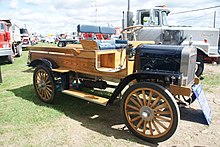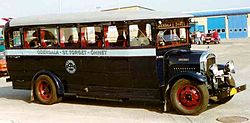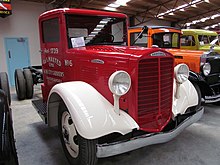



Brockway Motor Company was a builder of custom heavy-duty trucks in Cortland, New York, from 1912 to 1977.




Brockway Motor Company was a builder of custom heavy-duty trucks in Cortland, New York, from 1912 to 1977.
It was founded as Brockway Carriage Works in 1875 by William Brockway. His son George Brockway later turned the carriages into a truck manufacturer in 1909. The first trucks were high-wheelers. During World War I, Brockway built 587 Class B Liberty Trucks for the military. After the war they produced a new range from 1-ton to 5-tons.

They began with Continental engines but switched to Wisconsin in 1925. They bought the Indiana Truck Corporation in 1928 but were forced to sell it to White Motor Company in the early years of the Great Depression. A new range, the V1200 was offered from 1934 to 1937. The V1200 used a 240 hp (179 kW) V12 American LaFrance engine and carried loads up to 15 tons. [1]
During World War II, Brockway manufactured the B666 heavy truck, including the B666 Daybrook M-II-A bridge erector [2] and C666 Quick Way crane, [3] as well as G547 and G690 6-ton 6×6 bridging trucks, part of a standard design series also built by Corbitt and White. G547 "Treadway" trucks had a large hoist on the rear for self-unloading, while the G690 chassis were fitted with "Quickway" cranes, also used in bridging operations. [4]
All 6-ton military trucks (of all manufacturers) had Hercules HXD 855 cu in (14 L) I6 gasoline engines, developing 202 hp (151 kW) at 2150 rpm and 642 lbf⋅ft (870 N⋅m) of torque at 900 rpm. [5]
Post-World War II Brockway produced single and dual axle tractors and heavy duty triaxle dump trucks. The company was purchased by Mack Trucks Inc. in August 1956 and remained a division of Mack until its closing in June 1977. Mack cited "union troubles" for the closure. [6]
Brockway commercial trucks primarily used Cummins engines, though many were powered by Detroit Diesels. Some Brockway trucks were equipped with I6 engines fitted with Rochester 2G (DualJet) carburetors. [7]
There is a Brockway Truck show in Cortland each year with many events occurring at the official Brockway Museum located in Homer, NY at the Central New York Living History Center. [8]
The hood ornament used by Brockway was a husky dog with pulling harness, thus giving Cortland the nickname of "Huskie Town USA".
A documentary about the trucks and the Brockway company is available from Wiffle Ball Productions in Cortland, New York.

The Heavy Expanded Mobility Tactical Truck (HEMTT) is an eight-wheel drive, diesel-powered, 10-short-ton (9,100 kg) tactical truck. The M977 HEMTT first entered service in 1982 with the United States Army as a replacement for the M520 Goer, and since that date has remained in production for the U.S. Army and other nations. By Q2 2021, around 35,800 HEMTTs in various configurations had been produced by Oshkosh Defense through new-build contracts and around 14,000 of these had been re-manufactured. Current variants have the A4 suffix.

Mack Trucks, Inc. is an American truck manufacturing company and a former manufacturer of buses and trolley buses. Founded in 1900 as the Mack Brothers Company, it manufactured its first truck in 1905 and adopted its present name in 1922. Mack Trucks is a subsidiary of AB Volvo, which purchased Mack along with its then parent company Renault Véhicules Industriels in 2000.
The Chevrolet Stovebolt engine is a straight-six engine made in two versions between 1929 and 1962 by the Chevrolet Division of General Motors. It replaced the company's 171-cubic-inch (2.8 L) inline-four as their sole engine offering from 1929 through 1954, and was the company's base engine starting in 1955 when it added the small block V8 to the lineup. It was completely phased out in North America by 1962, but GM continued to build it in Brazil until 1979. It was replaced by the Chevrolet Turbo-Thrift engine.
Detroit Diesel Corporation(DDC) is an American diesel engine manufacturer headquartered in Detroit, Michigan. It is a subsidiary of Daimler Truck North America, which is itself a wholly owned subsidiary of the multinational Daimler Truck AG. The company manufactures heavy-duty engines and chassis components for the on-highway and vocational commercial truck markets. Detroit Diesel has built more than 5 million engines since 1938, more than 1 million of which are still in operation worldwide. Detroit Diesel's product line includes engines, axles, transmissions, and a Virtual Technician service.

Cummins Inc. is an American multinational corporation that designs, manufactures, and distributes engines, filtration and power generation products. Cummins also services engines and related equipment, including fuel systems, controls, air handling, filtration, emission control, electrical power generation systems, and trucks.
The GMC straight-6 engine was a series of gasoline-powered straight-six engines introduced in the 1939 model year by the GMC Trucks division of General Motors. Prior to the introduction of this new engine design GMC trucks had been powered by straight-six engines designed by the Buick, Pontiac and Oldsmobile divisions of GM.

The Diamond T Company was an American automobile and truck manufacturer. They produced commercial and military trucks.

The Mack Super-Liner is a model line of Class 8 trucks produced by Mack Trucks. Produced in North America from 1977 to 1993, the model line was a conventional-cab tractor configured primarily for highway and vocational applications, serving as the flagship conventional of the Mack product line in North America. Following its 1993 discontinuation, the Super-Liner was replaced by the CL700; today, its closest equivalent is the Mack Anthem.

The Mack R series is a series of trucks that was manufactured by Mack Trucks from 1966 to 2005. The successor of the Mack B series, the R was a heavy-duty truck with a conventional (bonneted) cab configuration. With the exception of the Kenworth W900, the Mack R is the longest-produced commercial truck in

The GMC CCKW, also known as "Jimmy", or the G-508 by its Ordnance Supply Catalog number, was a highly successful series of off-road capable, 21⁄2-ton, 6×6 trucks, built in large numbers to a standardized design for the U.S. Army, that saw heavy service, predominantly as cargo trucks, in both World War II and the Korean War. The original "Deuce and a Half", it formed the backbone of the famed Red Ball Express that kept Allied armies supplied as they pushed eastward after the Normandy invasion.
Continental Motors Company was an American manufacturer of internal combustion engines. The company produced engines as a supplier to many independent manufacturers of automobiles, tractors, trucks, and stationary equipment from the 1900s through the 1960s. Continental Motors also produced automobiles in 1932–1933 under the name Continental Automobile Company. The Continental Aircraft Engine Company was formed in 1929 to develop and produce its aircraft engines, and would become the core business of Continental Motors, Inc.

The Dodge WC series is a prolific range of light 4WD and medium 6WD military utility trucks, produced by Chrysler under the Dodge and Fargo marques during World War II. Together with the 1⁄4-ton jeeps produced by Willys and Ford, the Dodge 1⁄2‑ton G-505 and 3⁄4‑ton G-502 trucks made up nearly all of the light 4WD trucks supplied to the U.S. military in WWII – with Dodge contributing some 337,500 4WD units.

The Chevrolet Van or Chevy Van is a range of vans that was manufactured by General Motors from the 1964 to 1996 model years. Introduced as the successor for the rear-engine Corvair Corvan/Greenbrier, the model line also replaced the panel van configuration of the Chevrolet Suburban. The vehicle was sold both in passenger van and cargo van configurations as well as a cutaway van chassis that served as the basis for a variety of custom applications.

The Mack NO 7+1⁄2-ton 6x6 truck was a heavy 6x6 cargo truck designed in the 1940s by the American manufacturer Mack Trucks. It was used by the U.S. Army as an artillery tractor for heavy artillery during and after World War II. The official U.S. Army designation was: Truck, 7 1/2 ton, 6x6, Prime Mover. Its G-number was (G-532).

The Mack M123 (G792) was a 10-ton 6x6 semi-tractor introduced in 1955. The Mack M125 was a heavy cargo truck version of the M123. The M123 was used to tow tank transporter trailers while the M125 towed field artillery pieces.

The Mack NJU 5- to 6-ton 4x4 Ponton tractor (G639) was a semi-tractor designed to haul bridging equipment during World War II. Of the 700 built 119 were supplied to the British in Egypt, 8 were built with van bodies, and the rest were used as a substitute standard by the US Army.

Mack Trucks has been selling heavy duty trucks and buses to the United States military since 1911. Virtually every model has been used. The majority have been commercial models designed and built by Mack with their own components, but they have also designed and built military specification tactical trucks. The military vehicles are rated by payload measured in tons.

The 6-ton 6×6 truck was a family of heavy tactical trucks built for the United States Army during World War II. The basic cargo version was designed to transport a 6- short ton (5,400 kg) cargo load over all terrain in all weather. The chassis were built by Brockway Motor Company, The Corbitt Company, The Four Wheel Drive Auto Company (FWD), Ward LaFrance Truck Corporation, and White Motor Company. They were replaced by the M54 5-ton 6x6 trucks in the 1950s.